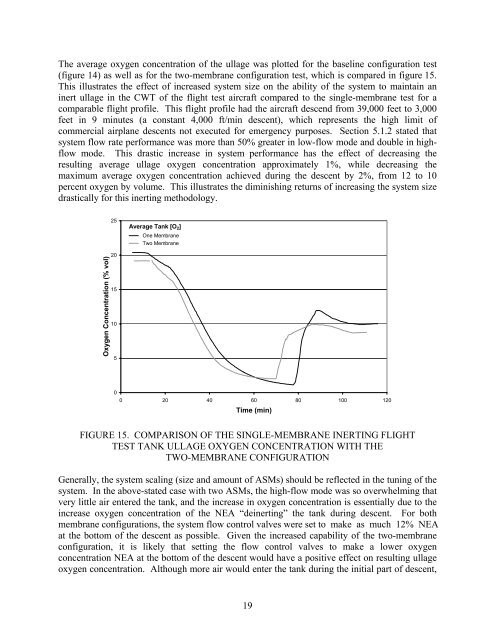Flight-Testing of the FAA Onboard Inert Gas Generation System on ...
Flight-Testing of the FAA Onboard Inert Gas Generation System on ...
Flight-Testing of the FAA Onboard Inert Gas Generation System on ...
You also want an ePaper? Increase the reach of your titles
YUMPU automatically turns print PDFs into web optimized ePapers that Google loves.
The average oxygen c<strong>on</strong>centrati<strong>on</strong> <str<strong>on</strong>g>of</str<strong>on</strong>g> <str<strong>on</strong>g>the</str<strong>on</strong>g> ullage was plotted for <str<strong>on</strong>g>the</str<strong>on</strong>g> baseline c<strong>on</strong>figurati<strong>on</strong> test<br />
(figure 14) as well as for <str<strong>on</strong>g>the</str<strong>on</strong>g> two-membrane c<strong>on</strong>figurati<strong>on</strong> test, which is compared in figure 15.<br />
This illustrates <str<strong>on</strong>g>the</str<strong>on</strong>g> effect <str<strong>on</strong>g>of</str<strong>on</strong>g> increased system size <strong>on</strong> <str<strong>on</strong>g>the</str<strong>on</strong>g> ability <str<strong>on</strong>g>of</str<strong>on</strong>g> <str<strong>on</strong>g>the</str<strong>on</strong>g> system to maintain an<br />
inert ullage in <str<strong>on</strong>g>the</str<strong>on</strong>g> CWT <str<strong>on</strong>g>of</str<strong>on</strong>g> <str<strong>on</strong>g>the</str<strong>on</strong>g> flight test aircraft compared to <str<strong>on</strong>g>the</str<strong>on</strong>g> single-membrane test for a<br />
comparable flight pr<str<strong>on</strong>g>of</str<strong>on</strong>g>ile. This flight pr<str<strong>on</strong>g>of</str<strong>on</strong>g>ile had <str<strong>on</strong>g>the</str<strong>on</strong>g> aircraft descend from 39,000 feet to 3,000<br />
feet in 9 minutes (a c<strong>on</strong>stant 4,000 ft/min descent), which represents <str<strong>on</strong>g>the</str<strong>on</strong>g> high limit <str<strong>on</strong>g>of</str<strong>on</strong>g><br />
commercial airplane descents not executed for emergency purposes. Secti<strong>on</strong> 5.1.2 stated that<br />
system flow rate performance was more than 50% greater in low-flow mode and double in highflow<br />
mode. This drastic increase in system performance has <str<strong>on</strong>g>the</str<strong>on</strong>g> effect <str<strong>on</strong>g>of</str<strong>on</strong>g> decreasing <str<strong>on</strong>g>the</str<strong>on</strong>g><br />
resulting average ullage oxygen c<strong>on</strong>centrati<strong>on</strong> approximately 1%, while decreasing <str<strong>on</strong>g>the</str<strong>on</strong>g><br />
maximum average oxygen c<strong>on</strong>centrati<strong>on</strong> achieved during <str<strong>on</strong>g>the</str<strong>on</strong>g> descent by 2%, from 12 to 10<br />
percent oxygen by volume. This illustrates <str<strong>on</strong>g>the</str<strong>on</strong>g> diminishing returns <str<strong>on</strong>g>of</str<strong>on</strong>g> increasing <str<strong>on</strong>g>the</str<strong>on</strong>g> system size<br />
drastically for this inerting methodology.<br />
Oxygen C<strong>on</strong>centrati<strong>on</strong> (% vol)<br />
25<br />
20<br />
15<br />
10<br />
5<br />
Average Tank [O 2]<br />
One Membrane<br />
Two Membrane<br />
0<br />
0 20 40 60 80 100<br />
Time (min)<br />
FIGURE 15. COMPARISON OF THE SINGLE-MEMBRANE INERTING FLIGHT<br />
TEST TANK ULLAGE OXYGEN CONCENTRATION WITH THE<br />
TWO-MEMBRANE CONFIGURATION<br />
Generally, <str<strong>on</strong>g>the</str<strong>on</strong>g> system scaling (size and amount <str<strong>on</strong>g>of</str<strong>on</strong>g> ASMs) should be reflected in <str<strong>on</strong>g>the</str<strong>on</strong>g> tuning <str<strong>on</strong>g>of</str<strong>on</strong>g> <str<strong>on</strong>g>the</str<strong>on</strong>g><br />
system. In <str<strong>on</strong>g>the</str<strong>on</strong>g> above-stated case with two ASMs, <str<strong>on</strong>g>the</str<strong>on</strong>g> high-flow mode was so overwhelming that<br />
very little air entered <str<strong>on</strong>g>the</str<strong>on</strong>g> tank, and <str<strong>on</strong>g>the</str<strong>on</strong>g> increase in oxygen c<strong>on</strong>centrati<strong>on</strong> is essentially due to <str<strong>on</strong>g>the</str<strong>on</strong>g><br />
increase oxygen c<strong>on</strong>centrati<strong>on</strong> <str<strong>on</strong>g>of</str<strong>on</strong>g> <str<strong>on</strong>g>the</str<strong>on</strong>g> NEA “deinerting” <str<strong>on</strong>g>the</str<strong>on</strong>g> tank during descent. For both<br />
membrane c<strong>on</strong>figurati<strong>on</strong>s, <str<strong>on</strong>g>the</str<strong>on</strong>g> system flow c<strong>on</strong>trol valves were set to make as much 12% NEA<br />
at <str<strong>on</strong>g>the</str<strong>on</strong>g> bottom <str<strong>on</strong>g>of</str<strong>on</strong>g> <str<strong>on</strong>g>the</str<strong>on</strong>g> descent as possible. Given <str<strong>on</strong>g>the</str<strong>on</strong>g> increased capability <str<strong>on</strong>g>of</str<strong>on</strong>g> <str<strong>on</strong>g>the</str<strong>on</strong>g> two-membrane<br />
c<strong>on</strong>figurati<strong>on</strong>, it is likely that setting <str<strong>on</strong>g>the</str<strong>on</strong>g> flow c<strong>on</strong>trol valves to make a lower oxygen<br />
c<strong>on</strong>centrati<strong>on</strong> NEA at <str<strong>on</strong>g>the</str<strong>on</strong>g> bottom <str<strong>on</strong>g>of</str<strong>on</strong>g> <str<strong>on</strong>g>the</str<strong>on</strong>g> descent would have a positive effect <strong>on</strong> resulting ullage<br />
oxygen c<strong>on</strong>centrati<strong>on</strong>. Although more air would enter <str<strong>on</strong>g>the</str<strong>on</strong>g> tank during <str<strong>on</strong>g>the</str<strong>on</strong>g> initial part <str<strong>on</strong>g>of</str<strong>on</strong>g> descent,<br />
19<br />
120
















